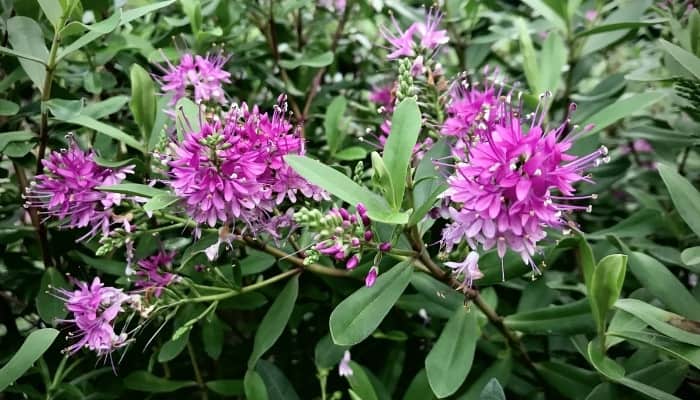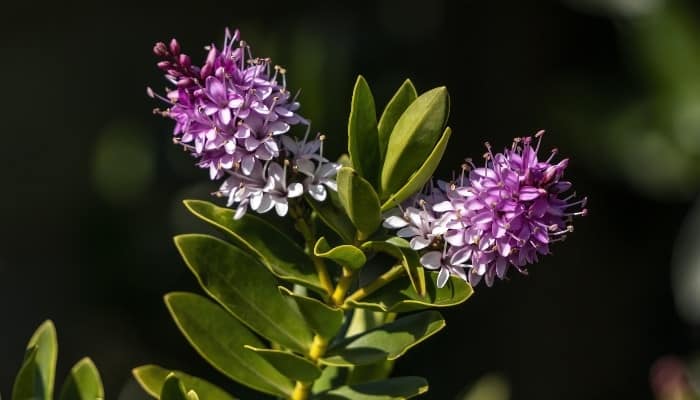Hebe shrubs, with their distinct beauty, are a common sight in numerous Growing Zones of the southern United States. These captivating plants have a compact, bushy appearance and yield charming, velvety blossoms.
However, if your hebe won’t flower, you’re missing out on the visual interest and appeal of this interesting plant.
For those having trouble getting their hebe to flower, keep reading to find out what might be wrong and how to fix it.
How do I get my hebe to flower? Hebe can adapt to a variety of environments, however, it needs optimal conditions to produce abundant flowers. This includes well-fertilized and well-draining soil, adequate sunlight, proper pruning, removal of spent blooms, space to grow, consistent watering, and a pest-free environment.
If that sounds complicated, don’t worry! Providing an optimal environment to help your hebe flower can be simple and easy.
In the following you’ll find out exactly how to make sure you don’t miss any of the important factors that work together to help your hebe reach its blooming potential.
How To Encourage Hebe Flowers
Many plants will grow and push out foliage easily, but blooming is another story altogether. Indoor and outdoor plants alike must be thriving and in optimal health to bloom.
Here’s your checklist to make sure your hebe is thriving come time to bloom.
Only Prune Lightly After Flowering – Not Before
Hebe plants bloom on new growth, so pruning adequately is one way to make sure your plant isn’t spending all its energy on feeding its foliage.
However, if you prune right before flowering, you’ll be sabotaging any chance you had of seeing blooms in the near future.
After your plant has bloomed, cut back each branch by at least half. This can also be done in early spring if you prefer.
This not only helps to encourage more of the plant’s energy toward new growth and blooms, but it also helps preserve a bushy and compact form for your plant and keeps it from getting leggy.
Be Sure Hebe Is Receiving Adequate Light
While hebe plants will tolerate shady conditions, they grow best in full sun.
If your hebe is planted in an area where it doesn’t receive enough sun, even though it might be growing well, it may fail to flower.
Add Nutrient-Rich Compost
If your hebe has been growing for a while and is failing to flower, try adding some compost. If you added compost when planting, then you may want to skip this step.
Hebe plants prefer poor soil, so too much compost can have a negative effect.
However, if your plant has never had an infusion of rich soil, try mixing a loam and compost mixture into the soil at a 1:1 ratio.
Apply Fertilizer
These plants don’t need much in the way of fertilizing. While many plants thrive from a nitrogen-rich fertilizer, hebe plants are the opposite.
Since their roots grow shallowly, too much nitrogen or phosphate may burn the root as well as encourage foliage growth instead of blooming.
Instead, consider applying slow-release feed, like this fertilizer designed specifically for flowering plants, or organic-matter fertilizer in the spring to encourage blooming.
Hebe plants also do well with fish-based fertilizers or even a homemade mixture of leftover fish and bone.
Ensure Soil Drains Well
Hebe plants need light and well-draining soil to thrive. If its soil is too compacted or heavy, a hebe plant will fail to thrive and won’t put out blooms.
A good way to remedy heavy or soggy soil is to add sand or a fast-draining soil mixture.
For planted hebe, since their roots grow shallowly, digging the plant up and supplementing the soil beneath will help keep its roots healthy and lead to easier blooming.

Water Consistently
Even though hebe is drought tolerant and dislikes soggy soil, this plant does need to be watered regularly to encourage blooming.
Especially growing outdoors in climates with temperatures beyond its preferred mild warmth, hebe plants need constant watering.
If it’s planted in dry conditions, water to keep the soil moist. Like many similar plants, hebe plants like to be watered consistently but not overwhelmingly.
Give around an inch of water a week to help keep soil light but appropriately wet.
Yellow leaves may be a sign that your hebe is getting too much or too little water either through watering itself or improperly draining soil.
Apply Mulch To Suppress Weeds
Hebe can fail to thrive when it’s surrounded by weeds.
Its shallow root system can be choked out by nearby plants, so make sure to suppress weeds by applying mulch and removing any unwanted plants that encroach on the hebe.
Remove Old Blooms Routinely
In addition to pruning after its blooming season, another way to encourage more flowering is to deadhead your hebe.
This means that once a singular bloom is spent, you should remove it from its stalk by gentle pinching, and continue to do this throughout its flowering season.
Check for Pests and Disease Damage Often
Hebe can be prone to several pests and diseases that can prevent it from blooming. Brown spots on the leaves can signal leaf spot, a fungus that can be treated with a plant fungicide.
Usually, leaf spot can be traced back to overwatering or soggy soil.
Several pests can enjoy munching on hebe leaves. You’ll see holes in the leaves or insect excrement left behind.
To remedy this, use diatomaceous earth (find it here) sprinkled on the leaves and around the plant to discourage insects. You can also pluck any caterpillars you see right off the plant.
How To Grow Hebe in Pots
To best control the environment and help your hebe flower, try potting it instead of planting it directly in the soil.
1. Choose a Pot or Planter With Drainage Holes
This is extremely important for helping your hebe maintain a healthy root system that can help produce blooms.
2. Choose a Well-Draining Soil Mix
Just as important is choosing soil that allows for quick draining but will stay moist.
Hebe plants also prefer poor soils, so adding sand or loam to a light and loose soil mix can help your plant flower.
3. Plant Your Hebe at the Right Level
Since these plants have shallow-growing roots, don’t plant them too deeply with too much soil under their root ball as this can contribute to root rot.
Make sure that the container is either shallow enough for this or that you plant the hebe lower in the container to make up for it.
4. Place the Container in a Sunny Spot and Water Well
In the right full-sun location, you won’t have to worry about root rot even when watering consistently.
The sun will help your hebe grow and also will help keep the soil from staying too soggy.
What Size Pot for Hebe?
When potting hebe, choose a container that is shallow enough to not overwhelm the plant’s shallow root system. A pot that is not taller than it is wide should do the trick.
What Is the Best Hebe for Containers?
Choose a hebe variety that won’t outgrow its container. The ‘Caledonia’ variety is a good, small hebe plant that still has a bushy appearance and beautiful foliage but stays small.
For very small planters, the smallest hebe variety, ‘Baby Marie’, won’t get taller than 16 inches.
Related Questions:
Still wondering about how to best care for your hebe so that it flowers? Keep reading!
What Month Do Hebes Flower?
Hebes flower from summer through fall, usually between June and September, but can flower for longer in milder growing regions.
Can You Grow Hebes From Cuttings?
Take a 3-4 inch section of stem, and remove the leaves from the bottom inch. Dip the bottom in rooting stimulant and place the cutting in the soil to propagate.
You’ll know roots have developed when you feel resistance when you tug gently on the cutting.
This rooting hormone is highly recommended, so I tried it recently and was quite happy with the results!
Conclusion
Hebe plants offer a wide variety of colors throughout the blooming season and are unmistakable for their textured flowers.
If you’re having trouble getting your hebe to flower so you can enjoy its beauty, try out some of these suggestions to help your plant thrive and bloom for years to come.

